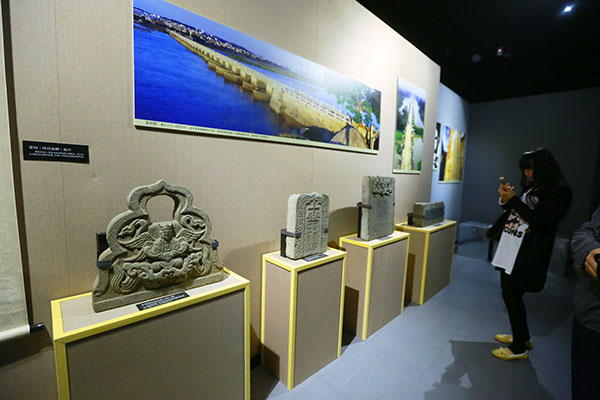
The Over the Sea show held in Quanzhou, Fujian province, presents more than 200 exhibits from nine cities on the ancient Maritime Silk Road.[Photo/China Daily]
A show of treasures from the Maritime Silk Road, titled Over the Sea, is on display at the Maritime Museum in Quanzhou, Fujian province.
The exhibition, which will run through March 8, presents more than 200 exhibit items from museums in nine cities that once played an active role on the crucial trade and cultural communication route.
The Maritime Silk Road, which ran from China through Southeast Asia and the Indian Ocean to Europe, started about the time of the Qin Dynasty (221-206 BC) and reached its peak during the Song (960-1279) and Yuan (1271-1368) dynasties. Chinese navigator Zheng He and his fleets in the early Ming Dynasty (1368-1644) also participated in maritime activity on the route.
-from-Penglai-(Shandong)-Museum-Photo-by-Dai-Hanqi.jpg)
A porcelain vase of the Yuan Dynasty (1271-1368) from Penglai Museum in Shandong province is on display at the show.[Photo/China Daily]
Nine sections, with each being dedicated to one city, are included in the display, focusing on various themes such as business and art exchanges.
Exhibits include not only a wide range of exported porcelain, silk pieces and other specialties from China, but articles such as jewelries and mirrors from Europe discovered in the country as well as products of ancient international contact, including some of the earliest Christian relics in China.
Wang Liming, deputy director of the maritime museum, says it is only right for Quanzhou to host the exhibition, since the city is known as the start of the Maritime Silk Road and was one of the largest ports in Asia during the Song and Yuan dynasties.
Different cultures met in Quanzhou when it served as an international port: One artifact reflecting such a multicultural past is a Christian stone carving that features an angel with four wings, Wang says.
“The winged angel resembling the image of a Buddha makes the carving exotic and look like a mixture of religions,” she says, adding the piece, a top-grade national treasure, has normally been replaced by a replica when shown at other events.
“It is the genuine one this time.”
Xie Bizhen, a historian with Fujian Normal University, notes the exhibition spotlights Fujian’s important role in the Maritime Silk Road: The province is the only one that has three cities presenting artifacts in the exhibition.
Zhangzhou displays its trademark blue-and-white porcelain as well as Dutch coins, while Fuzhou, the provincial capital, presents the exported clothes and the craftsmanship of building vessels, highlighting Fujian province’s heyday as a major hub for marine trade, Xie says.
Chen Xiangshun, a collector from Quanzhou, says the exhibition reflects the country’s archaeological research achievements.
The treasure horde of cultural relics on display, including chess pieces and coins, have been discovered from sunken merchant vessels of the Song Dynasty, which were loaded with porcelain ware and have been salvaged from the South China Sea in recent years, Chen says.
“It is hard to find those precious pieces, but they now remind me that there are still lots of other mysteries deep in the vast sea to be discovered,” Chen says.
The discoveries related to historical routes that link various cultures are getting international attention, and the Maritime Silk Road is an amazing network connecting the East and West, Xie says.
Last October, during his visit to members of the Association of Southeast Asian Nations, Chinese President Xi Jinping proposed the cooperation initiative of the 21st Century Maritime Silk Road.
“The exhibition offered inspiration to build a modern Maritime Silk Road, reminding us to take advantage of the experience we’ve had before to establish a mutual beneficial relationship with foreign countries,” Xie says.
To add fun for the younger generation of visitors, interactive games that invite children to identify a cultural relic based on a description have been designed, and winners could get postcards of the city that displays the item.
After the Quanzhou leg, the exhibition will go to Nanjing, capital of Jiangsu province, another of the nine cities highlighted in the show, as the tour nears its end.
